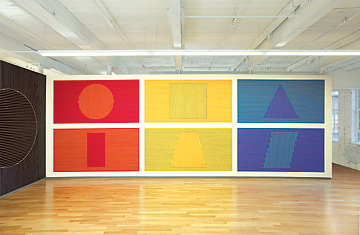
Sol LeWitt's Wall Drawing 340
Sol LeWitt was the man who made conceptual art an appealing concept. For almost four decades, LeWitt, who died last year at 78, made immense abstract wall drawings that he conceived but almost never executed himself. His method was to devise a set of instructions--for instance, draw 10,000 ten-inch lines, covering the wall evenly--that could be carried out by assistants or, for that matter, by anyone. Often he never even saw the finished work, much less touched it.
This cerebral formula turned out to be a recipe for irresistible eye candy. Draw 10,000 ten-inch lines, and you end up with a dynamic pattern of vector formations. A great LeWitt wall drawing may start like an algebra lesson, but it ends like a Renaissance fresco. Now you can see 105 of his drawings unfold themselves gorgeously across three floors of MASS MOCA, the Massachusetts Museum of Contemporary Art, in North Adams, Mass. In a very unusual arrangement, "Sol LeWitt: A Wall Drawing Retrospective" will remain on view there for at least 25 years. In effect, it's a quasi-permanent LeWitt museum. You should hurry to North Adams anyway. Life is brief, and this is something you don't want to miss.
The LeWitt retrospective grew out of conversations that began five years ago between the artist and Jock Reynolds, director of the Yale University Art Gallery. Thinking over ways to preserve LeWitt's work, Reynolds suggested a long-term installation of his wall drawings at MASS MOCA, which had opened in 1996 in a complex of almost two dozen derelict industrial buildings, most of them still unused by the museum. "I think Jock described me to Sol as a poor dirt farmer of a museum director," says MASS MOCA director Joe Thompson. "Cash poor but rich in buildings and land."
In 2004, LeWitt visited MASS MOCA, where he settled on Building Seven. Though he never returned to the site, he designed the installation himself, working with a scale model at his studio in Grafton, Conn. MASS MOCA engaged the architecture firm Bruner/Cott & Associates to produce a clean-lined renovation. Then the drawings were painstakingly executed over a six-month period by a combination of veteran LeWitt studio assistants, college students and local artists, about 70 people in all. The entire project, which also involves the nearby Williams College Museum of Art, cost $7.3 million.
The roughly chronological installation shows how LeWitt's work evolved over the years. Some drawings from the late '60s and early '70s are black pencil lines transecting penciled grids, things so delicate they seem to weigh little more than the thoughts they began as. Again and again, LeWitt introduced a human factor into what could otherwise have been a mechanical process. His instructions might call for one person to draw an irregular line and for others to attempt to imitate it. Early on, he brought color into the mix to produce agitated chromatic force fields. And in the '80s, after he moved for a few years from Manhattan to Spoleto, Italy, LeWitt began using big, broad phalanxes of colors so bright they play havoc with your retinas.
